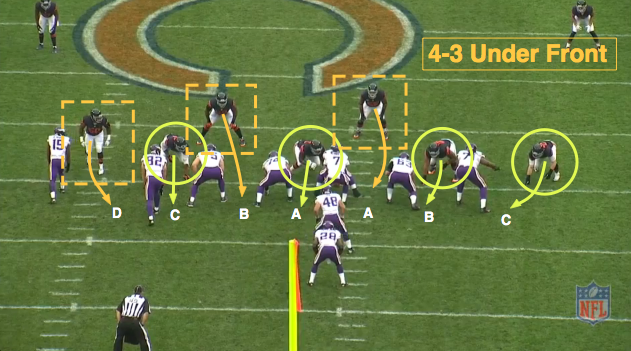Recent Forum Topics › Forums › The Rams Huddle › Are Hybrid Defenses the Future
- This topic has 4 replies, 4 voices, and was last updated 9 years, 10 months ago by
 Herzog.
Herzog.
-
AuthorPosts
-
July 6, 2014 at 7:28 pm #939
 wvParticipant
wvParticipantAre Hybrid Defensive Fronts the Future of NFL Defenses?
http://bleacherreport.com/articles/2117320-are-hybrid-defensive-fronts-the-future-of-nfl-defenses?utm_source=newsletter&utm_medium=newsletter&utm_campaign=nfl“….That’s why when we talk about “base alignments” and “two-down linebackers,” we’re using outdated terms. Weak-side linebackers who are too small to cover tight ends like Jimmy Graham and strong-side defensive ends who are too slow to rush the passer will struggle to find work in today’s NFL.
Pure run-stuffing middle linebackers and strong safeties who play like linebackers aren’t useful when teams are running three- and four-receiver sets and passing almost two-thirds of the time….”
w
v-
This topic was modified 9 years, 10 months ago by
 wv.
wv.
July 6, 2014 at 7:45 pm #945 znModerator
znModeratorI’m gonna put in the whole article pictures and all if you don’t mind.
July 6, 2014 at 7:52 pm #946 znModerator
znModeratorAre Hybrid Defensive Fronts the Future of NFL Defenses?
By Ty Schalter
Atlanta Falcons fans everywhere want to know the answer to one simple question: Will they be running a 3-4 or 4-3 base defense in 2014? Head coach Mike Smith is being obtuse about it.
“We’re going to play with 11 players on the field,” Smith told Vaughn McClure of ESPN.com.
Thanks for clearing that up, Coach.
Falcons defensive coordinator Mike Nolan has an extensive history with the 3-4 defense, and the Falcons acquired several 3-4 players this offseason, but Smith refused to admit such a switch was in the works. Instead, he argued the difference is much smaller than most football watchers realize.
“When you start talking about 3-4, 4-3, they’re very similar in principles,” Smith said. “You line up on a 4-3 in a base down, you slide your tackle in and under and over defense. You line up in a 3-4 and slide your tackle over, you’re in an over defense. You slide him under, you’re in an under defense.”
This runs counter to almost everything today’s fans know about defensive football.
The dominant defenses of the late 1990s and early 2000s relied on specialized schemes with defined roles and prototypes. Football fans who grew up watching Dick LeBeau’s 3-4 zone blitz and Monte Kiffin’s blitzless 4-3 Tampa 2 struggle to imagine the two base alignments as different names for similar things.
Even so, we’ve seen some of this flexibility elsewhere in the NFL; the New England Patriots have flexed between 3-4 and 4-3 fronts based on personnel throughout much of Bill Belichick’s tenure. Rob Ryan’s extremely multiple defense worked wonders in New Orleans last season—and the struggles of Ryan’s replacement in Dallas, Kiffin himself, had some Cowboys fans missing Ryan more than they might have expected.
What’s happening to defensive football? How are base alignments converging, and what does it mean going forward?
‘Base’ Alignment
When we talk about the differences between the 3-4 and 4-3 alignments, we need to know what those things are. There’s no better primer than Bleacher Report NFL Lead Writer Matt Bowen’s Football 101 articles on the topic.
Here’s Bowen’s “The Basics of the 4-3 Defensive Front” (http://bleacherreport.com/articles/1999358-nfl-101-the-basics-of-the-4-3-defensive-front), which walks us through the way 4-3 linemen and linebackers lineup and their relative responsibilities against the run and pass.
There are “Over” and “Under” 4-3 alignments. They’re “one-gap” systems, where each defender is responsible for defending one running lane. All of it is keyed off which side is “open” or “closed,” i.e. on which side the tight end is lined up.
This optimizes the run fits for the defense’s best run-stoppers. The nose tackle, strong-side linebacker and strong safety are all put into the best position to collapse the prime running lanes, and the defense’s best athletes (weak-side linebacker, pass-rushing defensive end, free safety) are free to chase down the play from the backside or guard against a counter.
Now, check out Bowen’s “The Basics of the 3-4 Defensive Front,” and scroll down to the 3-4 Under. Like a traditional 4-3, it’s a one-gap scheme keyed off the alignment of the tight end:

Just like Smith said, a one-gap 3-4 Under and a one-gap 4-3 Under are practically indistinguishable, as are a 3-4 Over and 4-3 Over:

Defensive coordinators running these alignments are asking similar athletes to do similar things—note that this open-side 4-3 “defensive end” isn’t even playing with his hand down.
Asymmetrical alignments, though, assume the offense is trying to run to the strong side—or even run at all. As New Orleans Saints tight end Jimmy Graham argued in his (unsuccessful) bid to be franchise-tagged as a wide receiver, today’s NFL tight ends function more like overgrown slot wideouts than hole-opening run-blockers.
In 2009, now-Buffalo Bills defensive coordinator Jim Schwartz told Detroit media members, quoted here via The Lions in Winter, why he prefers symmetrical linebackers and safeties:
We sort of got away (from WILL and SAM linebackers) because we saw so many shifting teams and teams get out of shifting real quick if they’re moving four people and you got all these guys on defense going, are you ready yet? But if they’re moving one guy and you’re flipping four, they’ll just do it 60 snaps a game.
That’s why you start getting a little less compartmentalized with SAM and WILL, strong safety and free safety. If you’re a strong safety and you line up to the tight-end side and that tight end motions across, you can’t flip because you don’t know if he’s going to stop and come back and if he does you’re looking bad. Guess what, if you have a 230-pound strong safety that’s an in-the-box strong safety you can turn him into the free safety just motioning one guy across the formation. So it puts more (emphasis) on having multidimensional (guys).
Old School, New School
As I recently wrote in a piece about the disappearance of the traditional between-the-tackles run-stuffing middle linebacker, NFL teams no longer run to establish the pass.
Leaguewide, NFL teams averaged 35.4 passing attempts and 2.5 sacks per game, compared to 27.1 rushing attempts. That means NFL teams averaged a 41.7/58.3 percent run/pass balance in 2014, per Pro-Football-Reference.com—and, of course, average means many teams are passing even more often. Even when teams run, it’s often out of passing formations.
That’s why when we talk about “base alignments” and “two-down linebackers,” we’re using outdated terms. Weak-side linebackers who are too small to cover tight ends like Jimmy Graham and strong-side defensive ends who are too slow to rush the passer will struggle to find work in today’s NFL.
Pure run-stuffing middle linebackers and strong safeties who play like linebackers aren’t useful when teams are running three- and four-receiver sets and passing almost two-thirds of the time.
That’s why teams are using nickel and dime packages at unheard-of rates.
“The thing that I think people don’t realize,” Smith said, via McClure’s report, “is that the game has become substitutional defense. About 65 to 75 percent of large snaps have been in sub defense where you’re playing with five defensive backs. There are more snaps with five defensive backs than four. That nickelback is more of a starter than your fourth linebacker or your third linebacker. The multiplicity and the complexity of the game have changed.”
As Bowen wrote, the traditional 3-4 Okie front uses a symmetrical defensive alignment: Three big, strong defensive linemen each responsible for two running lanes, leaving the outside linebackers responsible for edge containment. The power of old-school, aggressive 3-4 defenses like LeBeau’s is that they disguise where the pass rush is coming from.
The power of new-school 3-4 hybrids is that they disguise what the coverage is.
Ryan’s “base” defense is theoretically a two-gap 3-4, but as the author of the blog Code and Football wrote, he’ll use four, two, one or even zero defensive linemen to keep opposing quarterbacks confused. Ryan doesn’t need to overload the defense with six or seven pass-rushers to get a sack; he can do it by rushing an unexpected set of four or five and constantly changing which four or five come.
The limitation on 3-4 Okie front defenses has always been that two-gap nose tackle up front. There just aren’t enough athletic, 350-plus pound men who can handle two running lanes by themselves. When so few offenses rely on a traditional power run game, though, that’s not nearly the problem it used to be.
The door is open for coordinators like Nolan to go find talented, versatile players and start swapping them around.
Defender Taxonomy
The shift toward indistinguishable one-gap 3-4 and 4-3 fronts and wildly multiple “amoeba” defenses like Ryan’s is causing just as much confusion in football scouting and analysis.
When scouting, grading, ranking and giving awards to defenders, we break them down into categories that no longer make sense.
A 4-3 3-technique tackle such as Ndamukong Suh is similar to a 3-4 defensive end such as J.J. Watt, not a 3-4 tackle such as Vince Wilfork. A 4-3 defensive end such as Robert Quinn is similar to a 3-4 outside linebacker such as Brian Orakpo—not a 3-4 end such as Watt. A 4-3 outside linebacker such as Lavonte David doesn’t play anything like Orakpo.
Going forward, the football-watching world needs to consider classifying defenders in an alignment-agnostic way. These old descriptors (“tackles,” “ends,” “outside linebackers”winking smiley just don’t mean the same thing anymore.
Just like offensive coordinators are aggressively spreading the field, eliminating some positions (like fullback) and de-emphasizing the roles of others (like tight end), it makes sense that defensive coordinators are responding in kind.
Already, defensive coordinators are moving toward complex, hybridized, symmetrical alignments that give them maximum flexibility in coverage (and create maximum confusion). As the 2014 season approaches, don’t be surprised to hear more teams like the Falcons eschewing the idea of a “base alignment” altogether.
July 6, 2014 at 11:06 pm #967 InvaderRamModerator
InvaderRamModeratori’m not sure i understand what all of that means. but with guys like robert quinn, michael brockers, aaron donald, alec ogletree, and tj mcdonald. it seems like this defense has the ability to morph into a lot of different things. curious to see how this all develops this season.
July 7, 2014 at 4:42 am #1011 HerzogParticipant
HerzogParticipantIsn’t Mcdonald more of an in the box type safety? Doesn’t that mean he will be less effective in today’s NFL?
-
This topic was modified 9 years, 10 months ago by
-
AuthorPosts
- You must be logged in to reply to this topic.

